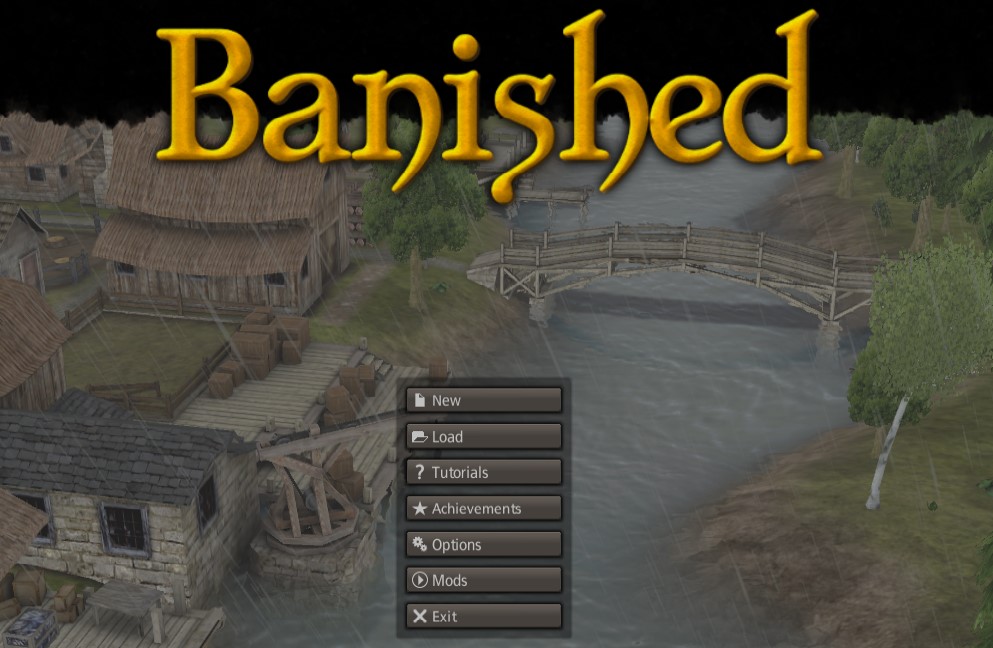You might know what Banished is, but for those of you who don’t, it’s a 10 year old video game. It’s a remarkable game, and would go on to influence future games in the city-builder genre.
In Banished, you’re managing a small band of people who have been banished from their original home. You start out in a completely undeveloped land that has a few basic resources, and from there, you build a new society.
The twist is that you’re responsible not just for managing resources, but for the survival of your colonists. You have to prevent starvation, generational population collapse, protect your settlement from disease and natural disasters. Growth is not a marker of success, but rather an inexorable condition of the game to be managed.
The main lesson I’ve taken away from Banished is this: if you’re going to take your band and build it into a thriving society of hundreds of people, you’re going to have to plan for resilience.
Diversify Your Inputs
A lot of times with these kinds of games, there’s one way to proceed to the end goal most efficiently. A best food to grow, a best industry to specialize in, and so forth. What makes the gameplay complex and interesting in Banished is that diversification is the best way to survive into the future.
For example, you might think that once you have the ability to start farming your own crops, it’s time to move on from the wild foods provided by gatherers, hunters, and fishermen. You could probably do that, but the problem is that an early freeze can destroy half of your harvest, and then when winter comes, your supplies are going to run out faster than you thought.
If you maintain your access to wild food sources, though, your people continue to gather food in the winter, while your fields and orchards aren’t producing. This allows you to supplement your stored food through the winter, reducing the possibility of famine conditions due to unusually harsh winter weather or even disease.
The same is true in real life. If you diversify your options for inputs, if one fails, you’ve got options to pivot to.
Implement Strategic Redundancy
Another option you have as your settlement grows is to keep livestock. You have three options: chickens, sheep, and cattle. Chickens produce meat and eggs, sheep produce meat and wool, and cattle produce meat and hide.
You keep livestock in a pasture, and each size of pasture can only hold a certain number of each animal. Once your pasture is full, you start harvesting animals for meat as more are born. So as your livestock reproduce they’re ramping up to full production.
For me, once the pasture is full, I have learned to not just let it run from there. Instead, I build a new pasture and split the existing herd. You might think that I do this to double my existing resource, but the main reason is something else entirely.
I do it because if there’s a disease or infestation in one pasture, I don’t lose my entire herd of animals.
I also keep pastures with the same kind of animals separated from each other, because these kinds of diseases and parasites can jump to new pastures over small distances.
When a disease hits, I cull the animals in that herd and then move a new kind of livestock into the now empty pasture.
Redundancy is often seen as a waste of resources in business, but having some strategic redundancy makes your organization more resilient. This includes large units like entire multinational businesses down to small teams. It doesn’t even mean just financial or physical resources. It also means skills and capacity.
Don’t Forget to Plan for Growth
Growth is inevitable as the game moves on. Your villagers will have children, they will grow old, and they die. They will only settle down and start a family once they have a house to live in. They can also die from accidents, starvation, hypothermia, and disease.
If your villagers aren’t replacing themselves, you’re going to experience a generational population collapse. You won’t have enough people to do all the work that your settlement requires, and freeze or famine may result, ending your game.
If your settlement grows too fast, your population will outgrow the settlement’s ability to feed and clothe your people. You’ll struggle to build new food sources fast enough, and suddenly one winter, your settlement starts to starve.
It’s possible to come back from this, but it’s challenging and it’s not particularly fun gameplay.
You manage growth in Banished through strategic building. If you build more houses, your population will grow faster, and if you don’t build houses, your population will not grow.
Sometimes, in real life, we strive for growth without planning for it. We fail to develop the infrastructure to support future growth until it is very urgently needed, which costs more and prevents us from making the best use of our new resources.
Managing the rate of growth and planning the infrastructure needed to support it might mean not growing as fast as we otherwise would, but it makes that growth less costly and more sustainable in the future.
Build Strong, Agile Networks
As you grow your population in Banished, you have to build more and more homes and other buildings. As you expand, your supply chain gets longer and longer until you struggle to supply those on the outer edges of your settlement.
Supplies are moved from place to place in Banished by laborers who pick supplies up from storage barns and run them to where they’re needed. Now, these folks can only travel across the map so fast, which can make some deliveries difficult to impossible. Also, folks who are making these long trips cannot do any other work while moving goods, so it makes your colony less productive. In theory, you could reach a point where the sprawl results in a colony that can no longer produce enough food to feed itself.
To manage this, you use roads (which help your citizens move from place to place faster) and markets (stocks goods for villagers to use) to create a network of distribution that avoids these extremely long trips. Markets employ vendors who take goods from storage areas and bring them to the market. So in order to avoid long trips for the vendors, you must also build storage barns and stockpiles strategically to make sure that those resources are available to the markets.
Whether you have to move inventory or cash from one part of the world to the other or just information from one team member to another, having strong, flexible, distributed networks is vital for resilience.
Maintain Excess Capacity
One of the ways that you manage your settlement is assigning jobs to your citizens. There are specialties like woodcutters, farmers, herdsmen, and hunters, but there’s also a pool of general laborers. At first glance, these folks seem like people who are just waiting to get a proper job, but your laborers are important in their own right.
Laborers do things like transport resources to building sites, move resources around generally, and go cut down trees and mine up stone and metal that are available in surface deposits. So if you assign all of your citizens to jobs, you’re going to find that things are not getting done.
That’s because your resources aren’t getting moved around, your builders don’t have the materials that you need to construct buildings, and extra wood and other resources aren’t being brought in to make up shortfall. Things will start to slow to a crawl, your settlement will start to stagnate, and a population crash looms on the horizon.
Excess capacity isn’t a waste. Excess capacity, to some extent, is needed across a network to give the organization the ability to respond to changing conditions on the ground. Excess capacity can help the organization deal with urgent changes and can help prevent disaster.
If you’re thinking that excess capacity costs money, you’re correct. When allowing for excess capacity, you will run into a point of diminishing returns. Because of this, you need to be strategic about excess capacity. Have just enough to offer agility, and distribute it where it’s needed most throughout your business.
Understand That Growth Reduces Your Impact
As your settlement grows in Banished, each thing you do is going to impact the settlement less and less. For example, when you have 20 citizens, a single farm will take up to 20% of your total workforce, but it will feed a lot of people. When you have 200 citizens, a single farm employs and feeds a much lower percentage of your population.
Larger and larger changes are needed to guide settlements as they grow, and by the time a disaster rears its head, you may not have the influence you need to head it off.
The same is true with organizations. The bigger it is, the more management it requires. This is why large organizations need many managers.
In real life organizations, our org charts act as force multipliers when used effectively. A single manager cannot have as much influence over 200 people as they did over 10. However, that single manager with 5 leads working for them can exert more influence than that manager could alone.
This was part of the problem with flattened hierarchy experiments like Tony Hsieh’s Holocracy. While it’s true that very stratified, multi-level hierarchies can introduce huge inefficiencies, some hierarchy is needed for organization of your workforce. In a large organization, one manager is only marginally more useful than no manager.
It’s amazing what you can learn from gaming (and any media, honestly) when you approach it with a sense of curiosity. Banished can be thought of as an analogue for basically any growing network, and what you learn watching your citizens die over and over again can be taken into nearly any other aspect of life (though hopefully with little to no actual death). Remember, just because your time isn’t spent working that doesn’t mean it’s unproductive time.


Leave a Reply